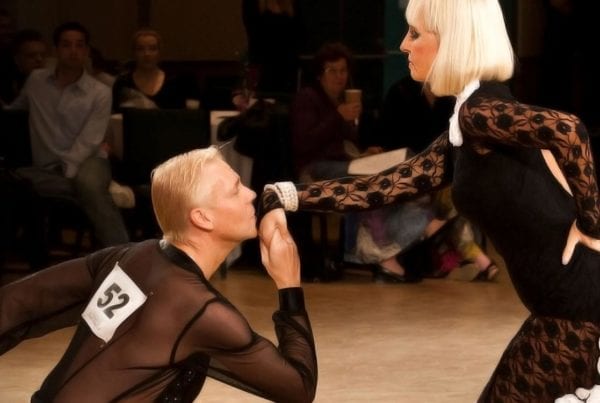It’s pretty easy for anyone learning to dance to be so busy thinking about their steps and technique that they are no longer dancing. Dancers learn about technique constantly. So how can one reconcile the process of learning technique while also ignoring that technique long enough to enjoy the dancing?
If you’re struggling with letting go of thinking, be assured first of all that you’re not alone. This is a universal issue facing almost all dancers. When I was still competing as an amateur, my coaches would be telling me the many ways I needed to improve. Every week I would be inundated with information about my shortcomings. Yet during competition I had to bring an overwhelming level of confidence to the floor, not showing any hint that things were falling short of ideal even when I knew they were. Fortunately I also received training in how to put aside the thinking process.
Thinking too much can affect dancers for different reasons. Let’s first look at the two main things dancers focus on because each one carries a different kind of thinking.
Two approaches to ballroom dancing
Ballroom dancing is a social activity, but there are two very different approaches people take when learning to ballroom dance.
Social Dancing
Social dancing is expressly about being able to dance spontaneously with strangers. Whether you’re a lead or a follow, the idea is to train yourself to be capable of taking a complete stranger in your arms and making it enjoyable to spend a few minutes with you, moving together.
For the man, this requires an ability to understand the basic figures for different dances, how to maintain his frame, and the technique to lead effectively. A good lead develops a sense of which foot his partner is on, is able to instinctively evaluate her skill level, and can adjust on the fly with suitable choreography to let her have fun during the dance without feeling awkward or uncomfortable.
For the lady, she needs to know the step patterns, how to hold her own frame and how to move efficiently from foot to foot so that she doesn’t hinder the couple’s movement and is able to move smoothly with any lead, even if led poorly.
Each partner’s task is challenging, but when these skills are learned anyone can dance with anyone else quite effectively. Social dancing is a beautiful skill and one that I consider an essential life skill for anyone who wants to become socially adept.
The danger for social dancers is to be thinking so much about your own technique that you are not aware of your partner and their needs. This causes men to stop leading and causes ladies to dance in the past or ahead of their partner, anticipating what’s next instead of dancing in the moment.
Performance Dancing
The other approach to ballroom dancing is to focus on developing the ability to dance at a high level so that others enjoy watching the performance. This is significantly different from social dancing in a number of ways. It is more demanding technically. It usually means dancing with the same partner so that the two of you develop an understanding of each other’s movements and personal styles to become more effective as a partnership. In most cases, it also means learning specific routines so that you develop the ability to move from one figure to another in the most seamless way possible. As a result, you may find yourself dancing the same routine over and over again instead of the variety of combinations that are a key part of social dancing.
Naturally, performance (which includes competition dancing) means that since you are focused on performing for others, you need much more than just great technique. You need to project confidence and energy outwards as these qualities are integral to a memorable performance.
The problem of overthinking for performance dancers is that they stop performing! A dancer who is thinking about technique is no fun to watch, no matter how good their technique may be.
A dancer who is thinking about technique is no fun to watch, no matter how good their technique may be
Both approaches to ballroom dancing, whether social or performance focused, require the participants to stop thinking because that gets in the way of accomplishing the goal.
So the next question is, how do we turn off that thinking process during the dance?
Putting technique in its place
As a dance teacher, I’ve heard some students tell me that they aren’t interested in learning technique; that they just want to be shown the steps. That’s kind of like saying that you don’t want to know how to cook a dish but instead just be told what ingredients are needed. Dance technique is there to ensure that the steps can actually be danced. Technique is about efficiency so that both partners are able to move together. Yet, while technique is important, there comes a time that we have to put it aside and just move to the music, allowing the muscles to use the information they learned as well as they are able.
Lesson and technical practice time are when you work on technical aspects of dancing. Here you focus on things like foot alignment, bent and straight legs, where to place each foot in relation to music and your partner, how to lead or respond to a lead and so on. Go through those things in detail and practice them slowly without music or with very slow music over and over to help train the muscles and the body to understand how it should feel.
Once the music comes on for actual dancing, you have to just ride with what you know at that point in time. It may be far from perfect, but you won’t fix any shortcomings during the dance. There are enough other things to think about, like what your partner is doing, floor craft and music. Don’t add another layer of thinking on top of that where you are worried about technique!
For the lady, thinking about technique causes her to dance in the past. At that moment she is no longer able to dance in the present. That means she will not only miss important lead cues but she can’t possibly be enjoying the experience of dancing. And if she isn’t enjoying it, then neither can others who are dancing with her or who are watching. The follow can only dance in the present moment every second of the dance. Focusing on the present allows her to project her beauty and enjoyment to her partner and others.
The man has plenty of things to think about already. He is listening to and interpreting the music, watching the floor space and planning his choreography, feeling what his partner is doing as she responds to his leads and making adjustments to accommodate her movements. When he adds technical thinking to the mix, something has to give. Usually this results in men with that “thousand yard stare,” or looking down at the floor during the dance. Even competitors, who have pre-planned routines that they’ve practiced hundreds of times, can fall into this trap. Even when the lady is projecting a beautiful confidence and performance energy, a lead who is thinking heavily can suck that energy away and leave a negative impression.
Practicing Performance
The good news is that confidence and performance energy can be practiced just as much as dance technique.
Start by being very much aware of what you are looking at during your dancing. Are you just staring into space, or actually looking at the environment around you? Pick objects on the wall that you can actively look at while dancing. Study them. In more intense dances like Tango or Paso Doble you can even work at burning holes with your eyes into objects like thermostats and light switches so that you learn to project your performance energy.
Feel what your toes and elbows and fingertips are doing. In the Latin dances, allow your fingers to project imaginary beams of energy outwards, as if you were Ironman. In the Ballroom dances, allow your energy to flow through your chest out to the audience and for your toes to project energy into the floor as you move. Feel the width of your arms by pulling your elbows as far apart as possible, allowing energy to flow outwards from the elbow joint of your upper arms.
Practice your breathing. Some dances, like Waltz, lend themselves very well to breathing exercises because the timing closely matches the breathing patterns we are used to. Learn where it feels right to breathe in and where to breathe out. In the Waltz, practice letting the lungs fill with air as you rise.
Practice distractions. Another great way to practice being able to dance without thinking is to allow yourself to think of other things while you are practicing. For example, you can count the number of chairs along the length of the floor while you are dancing, or the number of people in the room or something like that which has nothing to do with the dancing itself. It allows you to train the muscles to just do what they have to do without requiring mental involvement. We used to go to competition training events where the coaches would ask us questions while we were dancing.
Practice isolation exercises. Another coach used to prepare us for competition by making us focus on only one aspect of our dancing at a time, making everything else secondary. For example, just thinking about the body connection, or about the extension of the fingers in Latin, or about how we use energy on forward steps, etc. This isolates your mind from having a hundred things to think about so that you are only thinking of one thing. By doing this repeatedly with different areas of focus you can learn to ignore any of those aspects at will during your dancing.















Very interesting post, I am always struggling against “dancing in the past”, or because I am overthinking what I am supposed to do (and when I think it it’s just gone…) or because I try to record a strange (bad or good) sensation just happened. Another coach suggested to try overcoming this by “dancing in the future” i.e. try to focus sensations that are just going to happen.
Leads need to dance in both the present and the future, because they have to plan the floor craft. I even look ahead to how I expect the musical pattern might change so that I can optimize my planned choreography to the upcoming accents (or softness) of the music that’s playing.
Follows can only dance in the present. Ladies tend to want to know what’s ahead because, to the human brain, it would seem that if you know what’s going to happen next you can perform even better. But in dance that’s deadly. Only when the lady dances purely in the present can she really be empowered to do her best performance.
Amazing post!! I really liked reading it.
Thank you for providing such a great article.